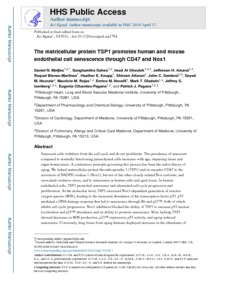Meijles, DN;
Sahoo, S;
Al Ghouleh, I;
Amaral, JH;
Bienes-Martinez, R;
Knupp, HE;
Attaran, S;
Sembrat, JC;
Nouraie, SM;
Rojas, MM;
et al.
Meijles, DN; Sahoo, S; Al Ghouleh, I; Amaral, JH; Bienes-Martinez, R; Knupp, HE; Attaran, S; Sembrat, JC; Nouraie, SM; Rojas, MM; Novelli, EM; Gladwin, MT; Isenberg, JS; Cifuentes-Pagano, E; Pagano, PJ
(2017)
The matricellular protein TSP1 promotes human and mouse endothelial cell senescence through CD47 and Nox1.
Sci Signal, 10 (501).
eaaj1784.
ISSN 1937-9145
https://doi.org/10.1126/scisignal.aaj1784
SGUL Authors: Meijles, Daniel Nathan
![[img]](https://openaccess.sgul.ac.uk/109343/1.hassmallThumbnailVersion/nihms915016.pdf)  Preview |
|
PDF
Accepted Version
Available under License ["licenses_description_publisher" not defined].
Download (2MB)
| Preview
|
Abstract
Senescent cells withdraw from the cell cycle and do not proliferate. The prevalence of senescent compared to normally functioning parenchymal cells increases with age, impairing tissue and organ homeostasis. A contentious principle governing this process has been the redox theory of aging. We linked matricellular protein thrombospondin 1 (TSP1) and its receptor CD47 to the activation of NADPH oxidase 1 (Nox1), but not of the other closely related Nox isoforms, and associated oxidative stress, and to senescence in human cells and aged tissue. In human endothelial cells, TSP1 promoted senescence and attenuated cell cycle progression and proliferation. At the molecular level, TSP1 increased Nox1-dependent generation of reactive oxygen species (ROS), leading to the increased abundance of the transcription factor p53. p53 mediated a DNA damage response that led to senescence through Rb and p21cip, both of which inhibit cell cycle progression. Nox1 inhibition blocked the ability of TSP1 to increase p53 nuclear localization and p21cip abundance and its ability to promote senescence. Mice lacking TSP1 showed decreases in ROS production, p21cip expression, p53 activity, and aging-induced senescence. Conversely, lung tissue from aging humans displayed increases in the abundance of vascular TSP1, Nox1, p53, and p21cip Finally, genetic ablation or pharmacological blockade of Nox1 in human endothelial cells attenuated TSP1-mediated ROS generation, restored cell cycle progression, and protected against senescence. Together, our results provide insights into the functional interplay between TSP1 and Nox1 in the regulation of endothelial senescence and suggest potential targets for controlling the aging process at the molecular level.
| Item Type: |
Article
|
| Additional Information: |
This is the author’s version of the work. It is posted here by permission of the AAAS for personal use, not for redistribution. The definitive version was published in Science Signaling on Vol. 10 17 Oct 2017, DOI: 10.1126/scisignal.aaj1784. |
| Keywords: |
Adult, Aged, Aging, Animals, CD47 Antigen, Cell Line, Cellular Senescence, Cyclin-Dependent Kinase Inhibitor p21, Endothelial Cells, Female, Gene Expression Regulation, Humans, Lung, Male, Mice, Inbred C57BL, Mice, Knockout, Middle Aged, NADPH Oxidase 1, RNA Interference, Reactive Oxygen Species, Signal Transduction, Thrombospondin 1, Tumor Suppressor Protein p53, Lung, Cell Line, Endothelial Cells, Animals, Mice, Inbred C57BL, Mice, Knockout, Humans, Reactive Oxygen Species, Thrombospondin 1, Signal Transduction, Gene Expression Regulation, RNA Interference, Aging, Adult, Aged, Middle Aged, Female, Male, Tumor Suppressor Protein p53, Cyclin-Dependent Kinase Inhibitor p21, NADPH Oxidase 1, Cellular Senescence, CD47 Antigen, 0601 Biochemistry And Cell Biology |
| SGUL Research Institute / Research Centre: |
Academic Structure > Molecular and Clinical Sciences Research Institute (MCS) |
| Journal or Publication Title: |
Sci Signal |
| ISSN: |
1937-9145 |
| Language: |
eng |
| Publisher License: |
Publisher's own licence |
| Projects: |
| Project ID | Funder | Funder ID |
|---|
| R42 AA024003 | NIAAA NIH HHS | UNSPECIFIED | | T32 GM008424 | NIGMS NIH HHS | UNSPECIFIED | | P01 HL103455 | NHLBI NIH HHS | UNSPECIFIED | | R01 HL112914 | NHLBI NIH HHS | UNSPECIFIED | | K23 HL112848 | NHLBI NIH HHS | UNSPECIFIED | | R01 HL108954 | NHLBI NIH HHS | UNSPECIFIED | | R21 EB017184 | NIBIB NIH HHS | UNSPECIFIED | | R01 HL098032 | NHLBI NIH HHS | UNSPECIFIED | | R01 HL079207 | NHLBI NIH HHS | UNSPECIFIED | | R01 HL123766 | NHLBI NIH HHS | UNSPECIFIED | | R01 HL125886 | NHLBI NIH HHS | UNSPECIFIED | | T32 HL007563 | NHLBI NIH HHS | UNSPECIFIED | | T32 HL110849 | NHLBI NIH HHS | UNSPECIFIED |
|
| PubMed ID: |
29042481 |
| Web of Science ID: |
WOS:000413108800001 |
| Dates: |
| Date |
Event |
| 2017-10-17 |
Published |
| 2017-09-20 |
Accepted |
|
 |
Go to PubMed abstract |
| URI: |
https://openaccess.sgul.ac.uk/id/eprint/109343 |
| Publisher's version: |
https://doi.org/10.1126/scisignal.aaj1784 |
Statistics
Item downloaded times since 21 May 2019.
Actions (login required)
 |
Edit Item |



